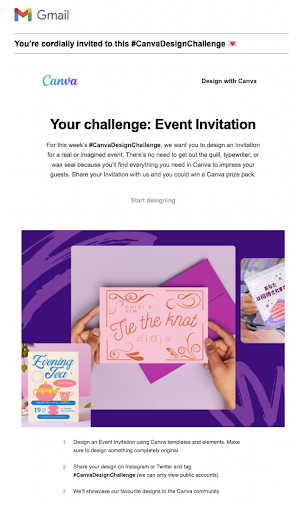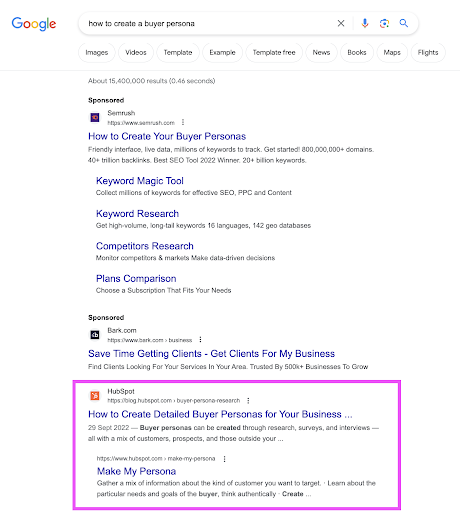Inbound marketing is a powerful technique for businesses—it's both cost effective and high impact. In fact, statistics show that inbound marketing generates three times more leads per dollar than traditional marketing methods. That’s an influx on return that can go right back into your campaigns, fueling a cycle that increases revenue over time.
But inbound marketing covers a wide range of techniques, so which are the best strategies for B2B and how should you implement them? Here I’ll share some of the most effective strategies and look at businesses doing it well.
What Is B2B Inbound Marketing?
The goal of B2B inbound marketing is to encourage your ideal business customer to actively seek out your products or services. It encompasses a range of different marketing techniques, from SEO to email marketing, but the overall aim remains the same—to create a business offering which is really attractive to your target customers so they want to buy from you.
Inbound Vs Outbound Marketing
As the name suggests, inbound marketing is all about encouraging your customers to come to you through things like high value content, engaging email marketing and SEO. Outbound marketing, on the other hand, is where you as a business actively try to sell to customers. This usually involves traditional marketing techniques such as cold calling potential customers, TV and radio ads or public relations.
B2C Vs B2B Inbound Marketing
The difference between B2C and B2B inbound marketing is down to the audience you are trying to attract. With B2C you are appealing to a consumer audience while B2B inbound marketing is designed to attract business customers. Since they are aimed at different audiences, they tend to use slightly different approaches
- B2C Inbound marketing: The customer is likely to be the person using the product. They are much more likely to be driven by emotion and impulse which means the buyer journey and the sales cycle tends to be shorter.
- B2B inbound marketing: The immediate customer is usually a buyer or decision maker working on behalf of a business. That means that the purchase decision is usually influenced by product efficiency, cost and ROI. The B2B buyer’s journey usually takes longer than B2C as it involves more research and stakeholders, meaning they’ll spend a little more time with your sales team.
Putting An Inbound Marketing Strategy Together
As with any marketing approach it's important to put together a comprehensive strategy. Follow our inbound marketing tips and the below steps to make sure you have a strategy that delivers quality leads for your business.
Get Clarity on Your Target Buyer
Inbound marketing is all about attracting the right buyer, so it’s absolutely vital that you get clear on who that ideal buyer is. Start by creating an ideal buyer persona. For a B2B customer, there will likely be two aspects to this: 1) the type of business that you want to sell to and 2) the individual who is likely to be doing the buying at that business.
Sometimes you might need more than one persona if you sell to large businesses as there could be the first point of contact and then another person who approves the purchase. When creating the persona, consider details like:
- Role - Job title, expertise and level of responsibility
- Personal information - Sex, age and interests
- Priorities - Pain points and problems they trying to solve
Then use this information to create relevant content that is engaging for this target buyer.
Set Your Goals and KPIs
You can’t measure the success of your strategy without goals and KPIs. When creating your KPIs, it's essential that you set goals that are realistic and specific (think about the SMART framework for setting marketing goals). For example, having a vague goal of increasing website users is not going to help you track the effectiveness of your marketing efforts.
Some KPIs that I use to evaluate the inbound marketing strategy for my online lifestyle business include:
- Email subscribers
- Lead magnet downloads/subscribers
- Website sessions and visitors
- Conversion rates and email open rates
- Keyword rankings
The metrics you measure will depend on the type of marketing campaigns you are using, so spend some time deciding on the goals that make the most sense for your business.
Analyze Opportunities and Competition
Learning from your competitors is one of the quickest ways to get clear on your marketing strategy and reap the benefits of good inbound marketing. This methodology is particularly useful for small business and startup marketing strategies, which need to be a bit more selective about where budget is spent.
Digital marketing has made reverse engineering your competitors' marketing strategies easier than ever. I recommend choosing three competitors - these could be businesses that are larger than you but which are going after the same target customer. Then, use SEO analytical tools such as SEMrush and Ahrefs to see what keywords their websites are ranking for, which of their articles or pages have the highest traffic and which other websites are linking to them. This will give you an idea of what topics are of interest to your target customers and also help you identify topics or problems that aren’t currently being addressed by your competitors.
Also have a look at your competitors’ social media profiles and chosen social media platforms—look at what they are posting, and more importantly, how their followers are engaging with their posts. What comments are they making and what questions are they asking? Are there opportunities there for you to produce a valuable piece of content to attract these potential customers?
Lastly, be sure to stay on top of the latest b2b marketing trends and tech so you can identify opportunities your competitors haven't even considered yet.
Ensure You Have an Engaging Website
For many businesses, your website is like your shop front. It needs to be engaging, professional and most importantly make potential customers feel confident in purchasing from you. This is particularly important for B2B customers who will often do more research before purchasing. Think back to your ideal customer and consider:
- Content - what information is going to be most useful and interesting for your target market? If your customer is interested in accounting software, then consider focusing your content creation on articles or video tutorials like ‘how to compile a tax return.’
- Layout - make sure your site is easy for customers to navigate. That means having clear CTAs, and easy to find help sections and contact details.
- Design - make sure your branding is consistent and professional across the whole site and all your marketing assets. You may also want to perform keyword research while designing your site, to ensure it’s optimized for SEO.
And remember to analyze how customers are using your website by tracking metrics like click through rates, bounce rates and website traffic. Build these into the KPIs we talked about so you can continually benchmark your progress and see where you need to make improvements.
Promote Using the Right Channels
In order for your ideal customers to find you, you need to promote your business in the right way and in the right places. After all, there is no point creating great content if your target audience doesn’t see it.
Refer back to your buyer persona and consider where they hang out online. What are the most important B2B publications or forums for your industry? Are there groups on LInkedIn or Reddit that are particularly active in your industry? If so, contributing to them could be a great way to engage with potential buyers.
When I worked as a marketing manager for a law firm we found that hosting webinars about the latest developments in the legal industry drove a huge proportion of our new business leads. Of course, it's helpful to set clear objectives and goals before you begin promoting.
B2B Inbound Marketing Strategies that Work
Whenever I’m coming up with a new marketing plan, I find it helps to get inspiration from businesses that I admire in my industry. So let's take a closer look at different B2B Inbound marketing strategies and the businesses that are really nailing these techniques.
High Value Content
Creating valuable content is one of the smartest ways to bring your ideal customer to your door. High quality content demonstrates your expertise which builds trust with your target audience.
In the B2B world, sales values are often higher but buyers therefore need extra reassurance of your expertise and ability to deliver, so good quality, useful content is often essential. Think about the type of content and messaging that your target audience will most appreciate and which best demonstrates your product. Content doesn’t just cover white papers and blogs—it covers everything from infographics to memes and influencer videos.Podcasts and videos can be a great way to show your brand personality and also simplify complex ideas. SEO business Moz created its hugely popular Whiteboard Friday—a weekly video series where a member of the Moz team explains a topic of interest like “How TikTok Is Reading Your Mind”. This has established Moz as a thought leader in their space and it’s an incredibly helpful resource for their target audience of SEO managers.

Email Marketing
Email is the preferred contact method for nearly 80% of B2B buyers, so it’s essential that you incorporate it into your inbound marketing strategy. Email is an ideal channel for building trust and loyalty with prospective and existing customers.
In my previous marketing role at a legal tech company, our monthly newsletter was one of the main sources of qualified leads. We would include an overview of upcoming changes in the legal industry, plus practical advice on how legal technology could help clients adapt to these changes.
Make sure you follow these guidelines to make sure your emails are as effective as possible:
- Provide value: your emails should be packed full of useful information which both helps your subscribers and demonstrates your expertise. For example, use your welcome email to provide a valuable case study, guide or promotion to engage your subscribers right from the start.
- Be consistent: if you send a regular email like a weekly email newsletter, make sure that it does go out every week and ideally at the same time. This will help to instill customer trust and build brand awareness.
- Make it attractive and easy to read: your emails should look professional and be easy for someone to read quickly. Make sure your subject lines are eye catching and compelling and the call to actions in your email are hard to miss.
- Personalize: build customer loyalty by ensuring that your readers only receive emails and content that is totally relevant to them. You can segment your email list to help with this.
- Make it mobile responsive: 81% of all emails are read on a mobile device, so above all else, make sure that your emails load properly on a mobile phone and the text, links, CTAs, and buttons are easy to view and interact with.
- Automate: B2B marketing automation platforms can do some of the heavy lifting for you, like automatically sending out pre-determined email messages with a certain action trigger.
Design software business Canva does this brilliantly. Their emails are beautifully laid out with clear CTAs and engaging copy. They regularly share advice and run design challenges which help to build a connection with their target audience.

Gated Content
Gated content is a really effective tool for lead generation, in fact 80% of B2B content marketing assets are gated. Gated content is still free but it typically involves your audience providing contact information in exchange for access to the content.
The content needs to be attractive enough to entice someone to provide their details so things like webinars, training videos, templates, whitepapers and eBooks tend to work well. If you’re marketing a SaaS business, live demos or free trials of your software can be a really good way of moving potential customers down the marketing funnel towards purchasing.
Shopify is a great example of this. By entering your email you get three days free access to their platform so you can trial the software. At the end of the trial, you receive an automated email which answers any questions you have and offers a limited time offer to encourage you to sign up.

Social Media
Social media allows you to demonstrate your brand personality and provide value to a potentially massive audience. While social media marketing may traditionally have been seen as a B2C tool, 75% of B2B buyers now use social media when making buying decisions.
Go back to the customer persona and think about what platforms are most popular with your target audience. Think about what your target audience looks for when using this platform. For example, if your audience uses LinkedIn, it may be that they are looking for professional analysis about the latest updates in their industry, while users of Twitter may be looking for more of a discussion about topical issues.
Social media offers a chance to engage with prospective customers in real time, so why not start a debate by running polls or sharing a unique perspective and asking for comments. Building a relationship with your audience creates trust which in turn leads to inbound marketing enquiries.
Slack uses Twitter to connect with its target audience through valuable guides, engaging videos and interesting discussions. As you can see, their posts are written in a personable way with eye catching graphics.

Paid Ads (PPC)
If you’re in a competitive industry like ecommerce, you may find it challenging to get in front of your ideal customer with content marketing or social media alone. This is where paid ads (also known as pay per click or PPC) can help. It’s why over 80% of B2B content marketers use social media ads.
You can run paid ads on almost any platform whether that’s Google ads, social media ads on Facebook or Instagram for example, or even marketplace specific ads like Amazon PPC. It’s all about finding out which platforms are most popular with your target audience. You don’t need to just advertise your website either. You can advertise landing pages with educational content or gated content such as free trials or guides.
Some companies like Zapier choose to run ads so that their website always appears at the top of Google when someone searches for their company. This helps to prevent sponsored ads for other competitor sites from appearing above their website in the results.

Search Engine Optimization (SEO)
Search engine optimization or SEO is one of the most important inbound marketing tactics because it's about making sure that your website is easy to find. This is particularly important for B2B buyers, 80% of which prefer to place orders through websites rather than other channels like social media.
SEO essentially involves optimizing your website so that it appears high up in search engine results. It includes a variety of tactics including:
- Optimizing for search engines: this includes making sure your website loads quickly, is mobile responsive, and the content on the site is structured so that it can be easily crawled by search engines.
- Building strong backlinks: when other reputable websites link to your website, it tells search engines that your website is good quality and should appear high up the search rankings.
Content SEO: this involves creating high quality content targeting specific keywords or questions that your target audience is likely to use. Companies like Hubspot do this particularly well. As a marketing software company, Hubspot knows that it’s target audience is likely to be searching Google for help with marketing questions such as “how to create a buyer persona”, so it puts together well researched high quality content which answers these questions and ensures that its website appears at the top of Google.

Plus, if you're looking to learn more about SEO, this amazing list of SEO newsletters is a great place to get the sort of insights you won't find on the SERPs.
Start Bringing In Customers
Now we’ve explored some high impact inbound marketing strategies, it's time to start putting them into action. Begin by creating your ideal customer persona so you can understand which marketing channels to focus on so you can start encouraging B2B customers to your door (and into your CRM).
While you’re here, check out our guide to building an efficient B2B marketing automation strategy to help you keep on top of your marketing tactics. And make sure you stay up to date with the latest marketing strategies for B2B companies by signing up to the CMO newsletter.


